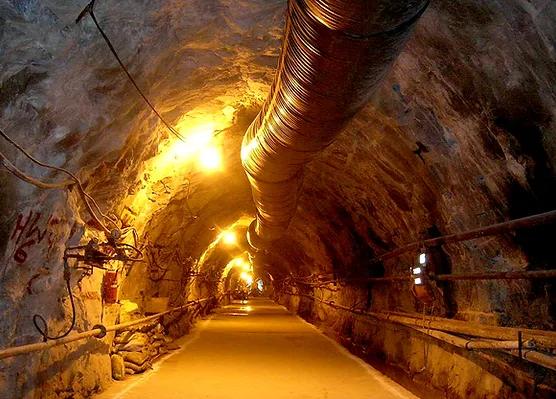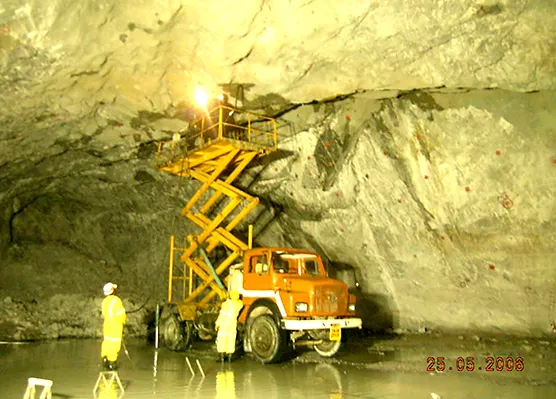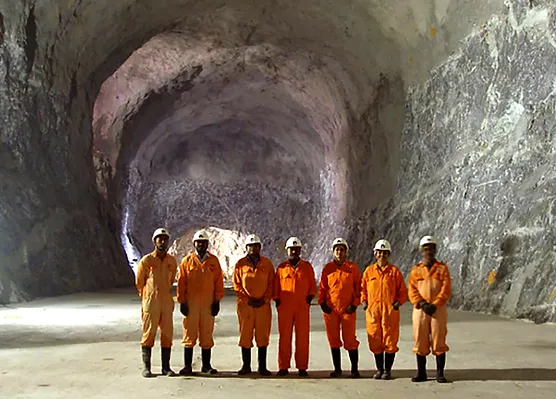India’s First Underground LPG Cavern
An invaluable asset for the nation’s LPG Industry.
Types of
LPG Storage

Ground Tanks
Above Ground Tanks are cylindrical bullet shaped tanks where LPG is stored under pressure.

Underground Tanks
Underground Storage tanks are tanks where LPG is stored underground. They are found at service stations, connected to boilers/steam generators, or connected to emergency generators.

Semi-Buried Mounded Tanks
Semi Buried Tanks are LPG storage tanks that are partially buried underground. Till recent years, bulk storage of highly inflammable Liquefied Petroleum Gas (LPG) was being done in above ground storage tanks. However some major fire / explosions underlined the need to review the design, procedure, maintenance, fire fighting and safety aspects of LPG handling.
A safer option was introduced in the form of Semi-Mounded LPG Storage Tanks since it provides intrinsically passive and safe environment and eliminates the possibility of BLEVE (Boiling Liquid Expanding Vapor Explosion). Mounded LPG Bullets are large, buried, horizontal cylindrical steel tanks with dished ends of size ranging between 3.5 to 7.0 meter diameter and lengths of 35 to 70 meters or more.
Underground Caverns- An Overview
An Underground Cavern is a fascinating engineering marvel, offering the safest solution for storing LPG / Propane. Caverns can be naturally occurring or man-made caves beneath the earth’s surface used by countries to provide national fuel security without harming the environment. An underground cavern occupies a small area isolated from external hazards like cyclones, fires, earthquakes, floods, or wars. These all factors makes the Cavern the safest and most sustainable way of storing hydrocarbons.
There are over 80 underground mined caverns around the world for LPG storage. At SALPG, the LPG is stored 162-181M below the ground level, which makes our cavern facility one of the world’s deepest and safest mined infrastructures to store energy. Our project is an innovative precursor for fuelling the future of energy security in India.





Project Summary
SALPG operates Asia’s first underground LPG cavern with a capacity to store 60,000MT of Propane. The Cavern is built using cutting-edge technology and a sophisticated design committed to delivering comprehensive LPG storage solutions to our clients. The deepest point of the cavern is 196 meters below sea level, equivalent to almost 16 floors down the earth and an impression larger than a football field.
The Cavern has three components: a water curtain gallery and two main LPG galleries, and more details as shown in the blueprint here:

Underground Caverns
that are used for storing LPG. The types of different underground storage are:

Disused Mines
Disused mines are existing deep mines that were used for coal storage. These can be used to store LPG.

Aquifer Reservoir
Aquifers are underground, porous and permeable rock formations that act as natural water reservoirs. Aquifers are the least desirable and most expensive type of natural gas storage facility for a number of reasons.

Depleted Oil and Gas Reservoirs

Salt Caverns
Salt caverns are typically much smaller than depleted gas reservoirs and aquifers. However, deliverability from salt caverns is typically much higher than for either aquifers or depleted reservoirs. Therefore natural gas stored in a salt cavern may be more readily (and quickly) withdrawn, and caverns may be replenished with natural gas more quickly than in either of the other types of storage facilities. Moreover, salt caverns can readily begin flowing gas on as little as one hour’s notice, which is useful in emergency situations or during unexpected short term demand surges. Salt caverns may also be replenished more quickly than other types of underground storage facilities. Underground salt formations are well suited to natural gas storage in that salt caverns, once formed, allow little injected natural gas to escape from the formation unless specifically extracted. The walls of a salt cavern are strong and impervious to gas over the lifespan of the storage facility.

Mined Caverns
Mined Rock Caverns are mined underground using conventional mining techniques and consist of a system of shafts or ramps and drifts, forming cavities in solid rock deep underground, for example, in granite. Conventionally mined rock caverns are underground cavities constructed by using conventional mining techniques (shaft sinking, excavation of cavities by blasting or cutting). Mined rock caverns can be constructed in a certain range of geological formations which need to allow for the construction and operation of large, long-term stable caverns. These formations were initially considered intrinsically impervious to water and hydrocarbons. Later designs in the fractured rock used the head of water as a water curtain (hydrodynamic containment) to contain the hydrocarbon.
Potential Beyond the Surface
From the experiences of Scandinavian and other countries, keeping LPG in underground rock caverns is much safer than using above-ground tanks or spheres. Nearly 80 LPG storage caverns operate in the world today.
- Underground Caverns are the safest way to store LPG as they are sheltered from natural or man-made calamities.
- The risk of fuel leakage is none, thus, making caverns environment friendly.
- Underground caverns occupy less surface area compared to other LPG storage alternatives.
- Building a cavern infrastructure preserves the project area’s natural landscape and scenic beauty, as most installations are underground.
- The cavern facility is a strategic asset for the country’s energy logistics as it facilitates bulk storage of LPG at a cheaper cost than other storage facilities.
- Underground storage caverns give efficient results with very little maintenance and usually have a longer service life.
